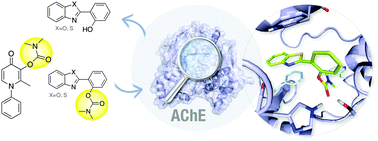Exploring the multifunctionality of thioflavin- and deferiprone-based molecules as acetylcholinesterase inhibitors for potential application in Alzheimer's disease†
Abstract
Alzheimer's disease (AD) is a devastating neurodegenerative disease that affects millions of people worldwide. With no prevention or cure available, this progressive disease has a significant impact on society – dementia patients and their caretakers, healthcare systems, and the economy. Previously, we have reported initial developments of multifunctional drug candidates for AD based on two scaffolds – thioflavin-T and deferiprone. Individually, these molecules have shown several favorable functionalities, including dissociation of toxic amyloid-β aggregates, antioxidant and/or metal chelating ability that can pacify reactive oxygen species, plaque targeting, and blood–brain barrier penetration. In this work, the two scaffolds are augmented with a new functionality – acetylcholinesterase inhibition. This functionality is incorporated by derivatization with a carbamate group, which is the active group in some AD drugs currently in the market. We present the rationale for designing three novel compounds, their synthesis and characterization, including X-ray crystallographic data, and encouraging results from in vitro and computational acetylcholinesterase inhibition studies. Also, we evaluate the compounds as potential drug candidates by Lipinski's rules and cytotoxicity studies in a neuronal cell line. Overall, we demonstrate the feasibility of improving on two well established scaffolds, as well as show in vitro efficacy plus initial mode of action and biological compatibility data.


 Please wait while we load your content...
Please wait while we load your content...